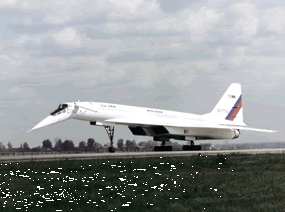|
The Russian Concorde Tupolev TU-144

A result of the cold war's technology rivalry
when the Soviet Union copied many things the west made including the Concorde
and Space Shuttle. The Tupolev TU-144 was one of the Soviets least successful
project. Built as a competitor to the Anglo-French Concorde from modified plans
stolen from the French it was the first supersonic commercial aircraft beating
Concorde by two months.
The programs first disaster was when a TU-144 (or Concordski as the media called
it) crashed in front of TV-cameras during a presentation at the Paris Air Show
1973. The French had sent up a Mirage III jet to photograph the TU-144 in
flight, but did not tell the Russians. The plane found itself on a collision
course with the Mirage when they took evasive action the plane stalled and then
when they tried to recover from the stall they overstressed the air frame
causing the plane to break-up and crash, It was also suggested that the pilot
who was under pressure to show off the planes abilities against the Concorde,
possible was pushing the plane too hard when he attempted the steep climb that
caused the stall.
After several modifications the Concordski was put back into service on mail and
cargo runs as the TU-144D between Alma Ata and Moscow in 1975. The Russians
wanted to prove the plane was safe before starting passenger service in 1977. A
second crash soon after passenger service began put commercial service on hold
again in 1978. while a third crash landing sealed the fate of the TU-144 with
the last jet to fly in 1985.
The TU-144 could hold 40 more people than the Concorde and was slightly faster
but it used more fuel and had less range, only 17 TU-144's including 1 prototype
and 5 TU-144D models were built, while there were 16 production and 4 prototype
Concorde's built, 14 of which went on sale to Air France and British Airways.
The TU-144 flew again in the mid-1990s, when Boeing and NASA partnered with
Tupolev to test supersonic flight. using a heavily modified TU-144D was renamed
TU-144LL and set up as a flying test laboratory for future supersonic
development. Developed for NASA's High-Speed Civil Transport program it made 32
flights up to 1999 near Moscow. Since then Boeing has shelved plans for a
supersonic plane deciding to continue improvements on their 777 series jets.
NASA's part in the project has also stopped as their hopes for large scale use
of supersonic aircraft had proven too costly.
|
